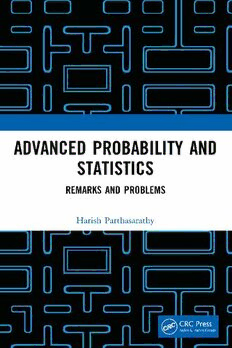Table Of ContentAdvanced Probability and Statistics:
Remarks and Problems
Advanced probability and statistics Part
II:Remarks and Problems
Harish Parthasarathy
ECE Division, NSUT
May 30, 2020
Advanced Probability and Statistics:
Remarks and Problems
Harish Parthasarathy
Professor
Electronics & Communication Engineering
Netaji Subhas Institute of Technology (NSIT)
New Delhi, Delhi-110078
First published 2023
by CRC Press
4 Park Square, Milton Park, Abingdon, Oxon, OX14 4RN
and by CRC Press
6000 Broken Sound Parkway NW, Suite 300, Boca Raton, FL 33487-2742
© 2023 Manakin Press
CRC Press is an imprint of Informa UK Limited
The right of Harish Parthasarathy to be identified as author of this work has been asserted in
accordance with sections 77 and 78 of the Copyright, Designs and Patents Act 1988.
All rights reserved. No part of this book may be reprinted or reproduced or utilised in any
form or by any electronic, mechanical, or other means, now known or hereafter invented,
including photocopying and recording, or in any information storage or retrieval system,
without permission in writing from the publishers.
For permission to photocopy or use material electronically from this work, access www.
copyright.com or contact the Copyright Clearance Center, Inc. (CCC), 222 Rosewood Drive,
Danvers, MA 01923, 978-750-8400. For works that are not available on CCC please contact
mpkbookspermissions@tandf.co.uk
Trademark notice: Product or corporate names may be trademarks or registered trademarks,
and are used only for identification and explanation without intent to infringe.
Print edition not for sale in South Asia (India, Sri Lanka, Nepal, Bangladesh, Pakistan or
Bhutan).
British Library Cataloguing-in-Publication Data
A catalogue record for this book is available from the British Library
Library of Congress Cataloging-in-Publication Data
A catalog record has been requested
ISBN: 9781032405155 (hbk)
ISBN: 9781032405162 (pbk)
ISBN: 9781003353447 (ebk)
DOI: 10.4324/9781003353447
Typeset in Arial, Calibri, Cambria Math, Century Schoolbook, MT-Extra, Symbol MT,
Tahoma, Verdana, Wingdings, Palatino, Monotype Corsiva, Euclid Extra, KozGoPr6N,
Minion Pro, Symbol and Times New Roman
by Manakin Press, Delhi
Preface
The chapters of this book deals with the basic formulation of waveguide cavity reso-
nator equations especially when the cross sections of the guides and resonators have
arbitrary shapes. The focus is on expressing the total field energy within such a cavity
resonator as a quadratic form in the complex coefficients that determine the modal
expansions of the electromagnetic field. Such an expression can then be immediately
quantized by replacing the coefficients with creation and annihilation operators.
The reviews of basic statistical signal processing covering linear models, fast al-
gorithms for estimating the parameters in such linear models, applications of group
representation theory to image processing problems especially the representations of
the permutation groups and induced representation theory applied to image process-
ing problems involving the three dimensional Euclidean motion group. Some atten-
tion has been devoted to quantum aspects of stochastic filtering theory. The UKF as
an improvement of the EKF in nonlinear filtering theory has been explained.
The Hartree-Fock equations for approximately solving the two electron atomic
problem taking spin-orbit magnetic field interactions into account has been discussed.
In the limit as the lattice tends to a continuum, the convergence of the stochastic dif-
ferential equations governing interacting particles on the lattice to a hydrodynamic
scaling limit has also been discussed. Statistical performance analysis of the MUSIC
and ESPRIT algorithms used for estimating the directions of arrival of multiple plane
wave emitting signal sources using an array of sensors has been outlined here. It is
based on our understanding of how the singular value decomposition of a matrix gets
perturbed when the given matrix is subject to a small random perturbation. Finally,
some aspects of supersymmetry and supergravity have been discussed in the light of
the fact that supersymmetry is now a mathematically well-defined field of research
that has opened up a new avenue to our understanding of how gravity can be unified
with the other fundamental forces of nature. This book is based on the lectures deliv-
ered by the author to undergraduate and postgraduate students. These courses were
on transmission lines and waveguides and statistical signal processing.
Author
v
Table of Contents
1. Remarks and Problems on Transmission Lines and Waveguides 1–18
2. Remarks and Problems on Statistical Signal Processing 19–132
3. Some Study Projects on Applied Signal Processing with
Remarks About Related Contributions of Scientists 133–205
vii
Chapter 1
Chapter 1
Remarks and Problems on
Remarks and Problems on
Transmission Lines and
Transmission lines and
Waveguides
Waveguides
[1]Study about the historical development of the Maxwell equations for elec
tromagnetism starting with the experimental findings and theoretical formula
tions of Coulomb, Ampere, Oorsted, Faraday, Gauss and finally culminating in
Maxwell’s introduction of the displacement current to satisfy charge conserva
tion in time varying situations. Study about how Maxwell converted all these
findings into laws expressible in the form of partial differential equations based
on the basic operations of vector calculus and how by manipulating these equa
tions, he proved that electric and magnetic fields propagate in vacuum as plane
waves travelling at the speed of light and thereby how he unified light with elec
tricity and magnetism. Study about how Heinrich Hertz confirmed Maxwell’s
theory hundred years later using Leyden jar experiments.
Max Planck struggled for over twenty years to finally arrive at his law for
the spectrum of black body radiation. The earlier law for this spectrum that
was being used was Wien’s displacement law according to which the spectral
density of black body radiation was proportional to
S(ν)=C ν3 .exp( βν)
−
With β = A/T with A a constant. At very low frequencies this law states
that the spectral density is proportional to ν3 . The same is true at very high
temperatures. At very low temperatures, this law predicts that the spectrum
will vanish, ie, there will not be any radiation at all. The high temperature
and low frequency limit of Wien’s displacement law was in sharp contradiction
with experiment. Planck used a little of statistical mechanics but more of curve
9
1

